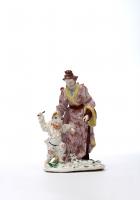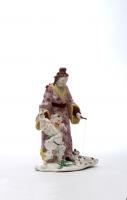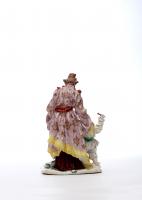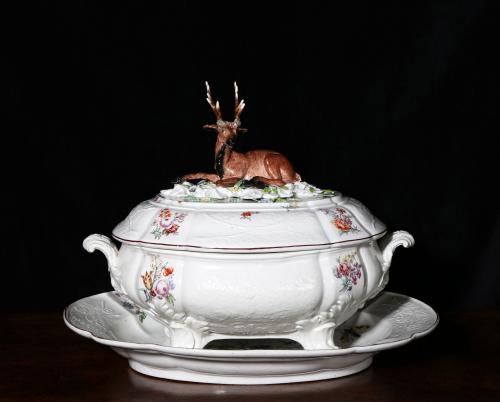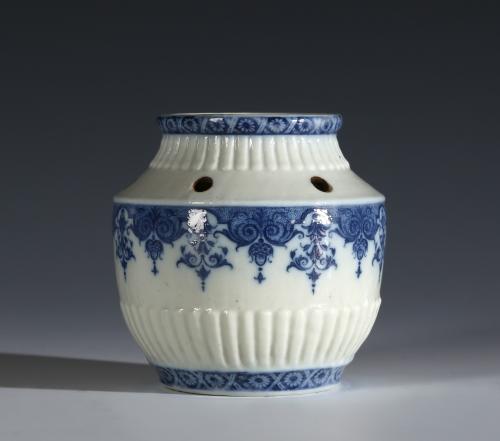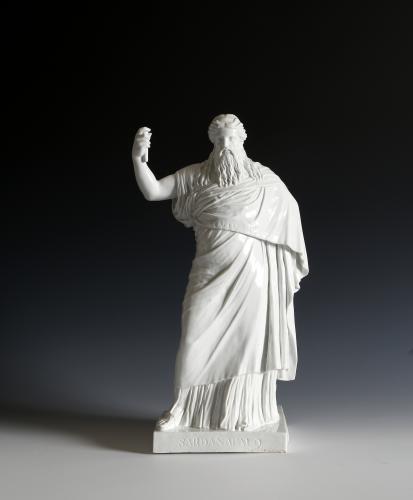
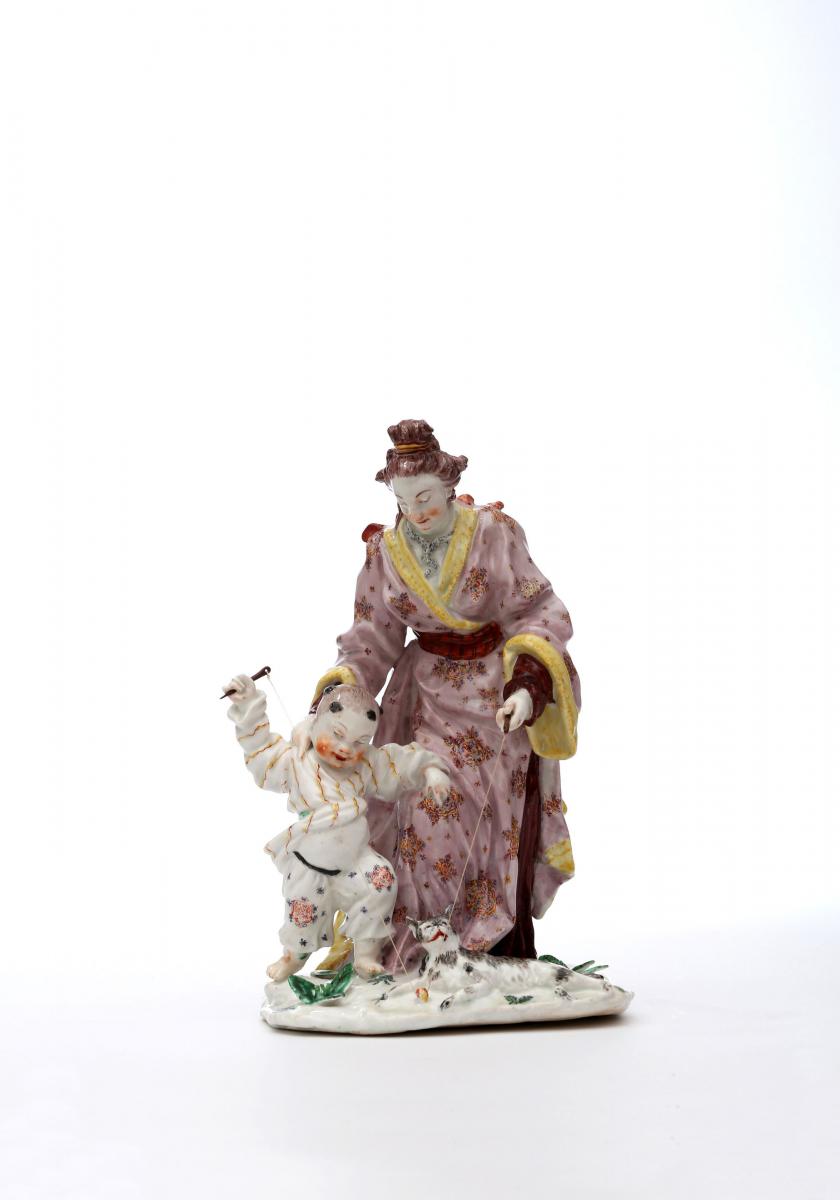
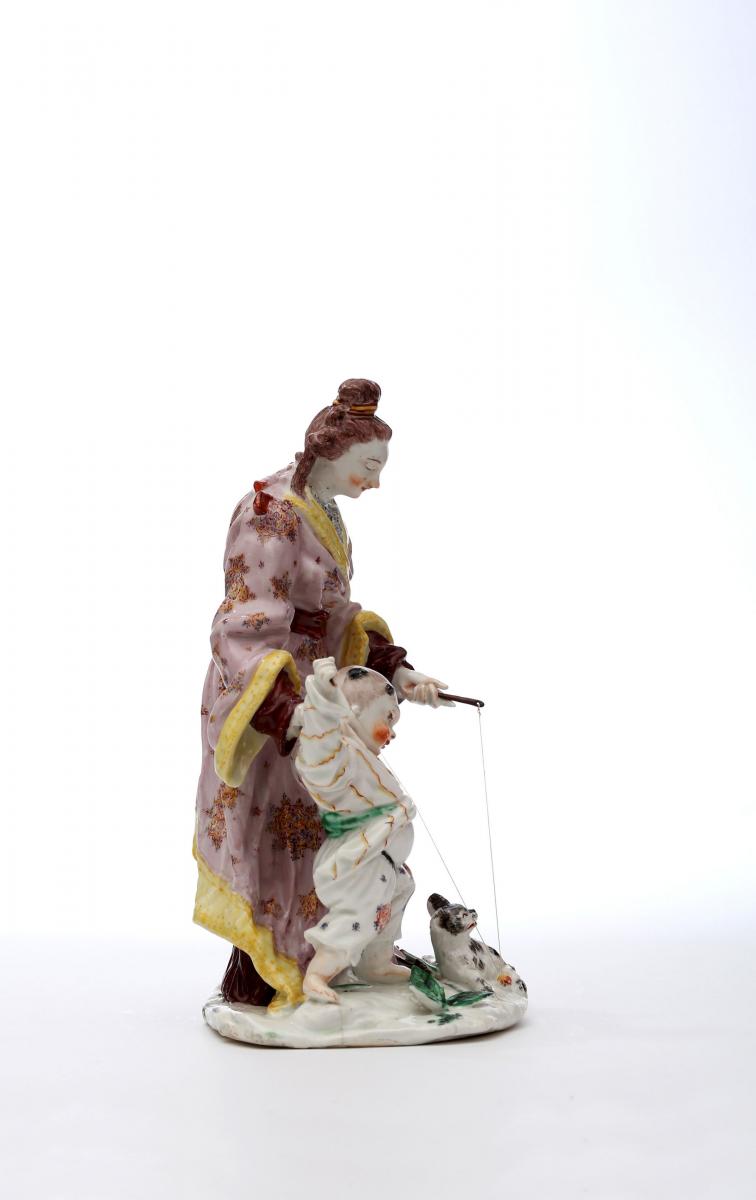
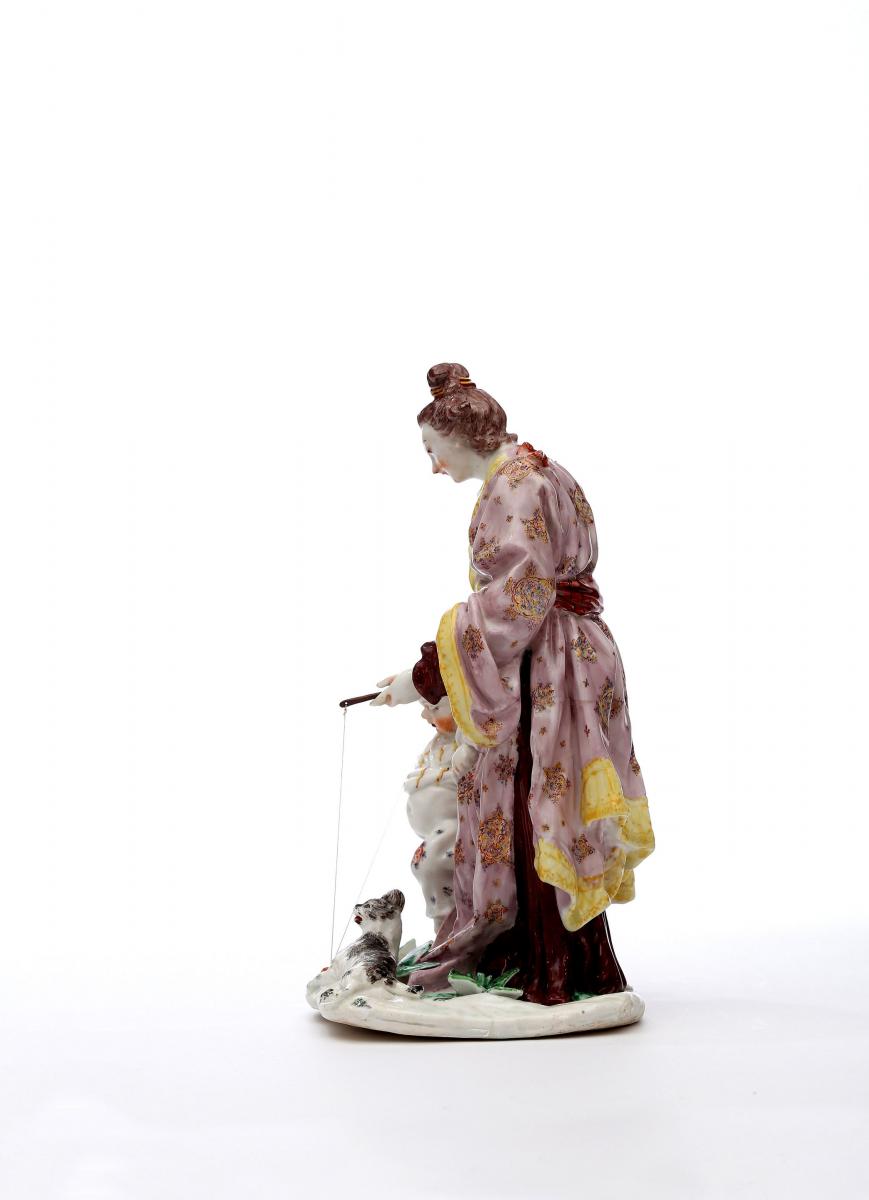
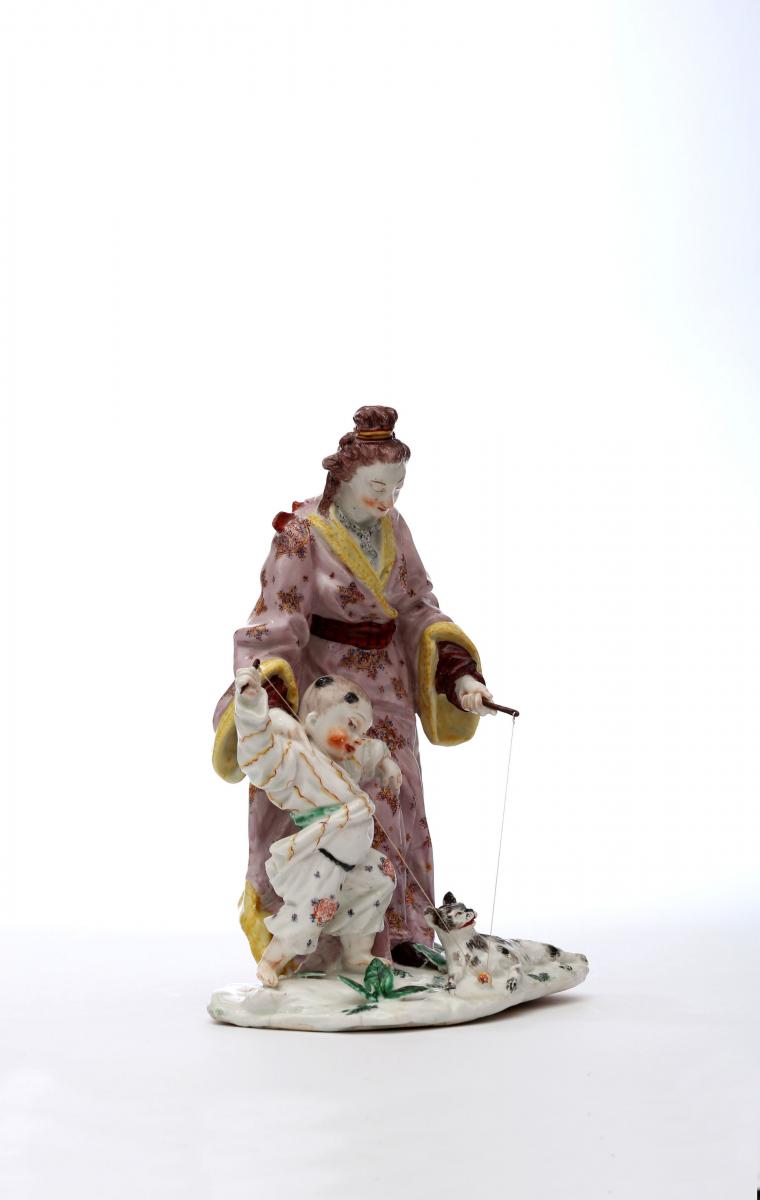
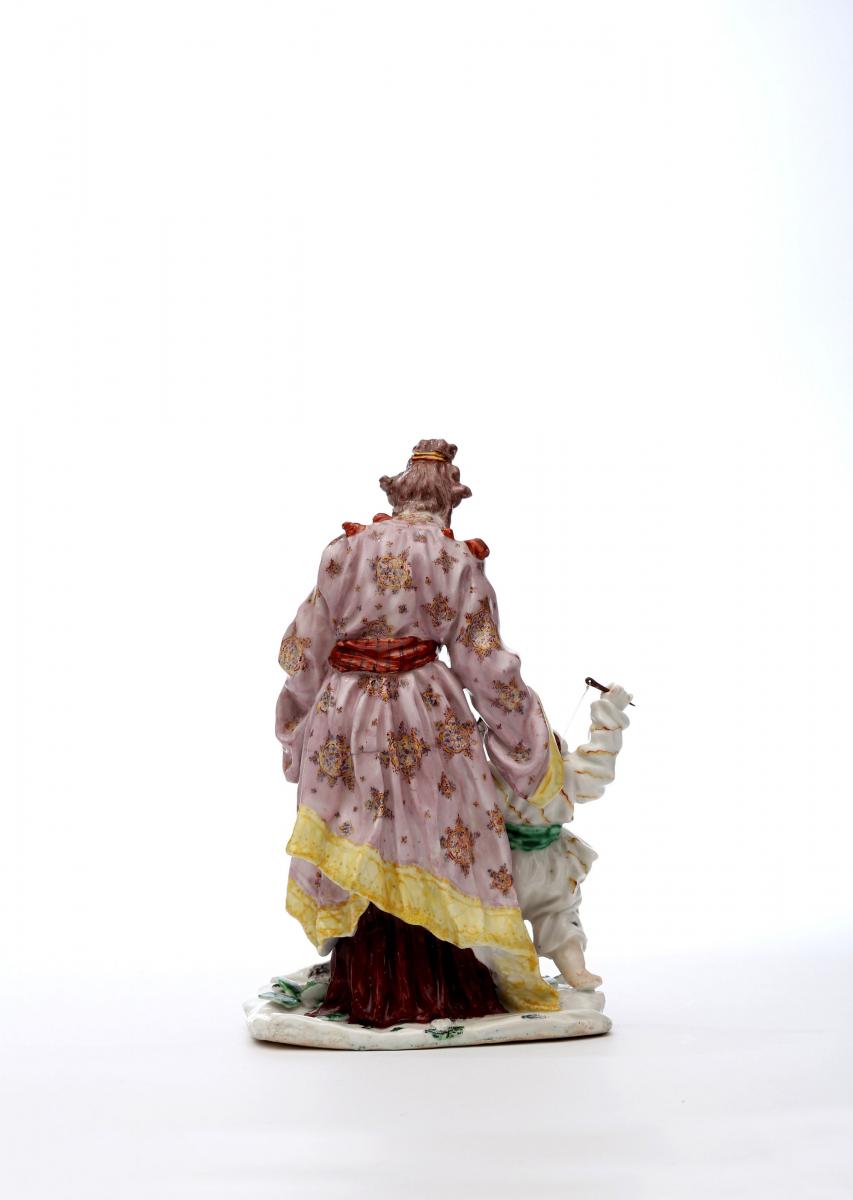
Price
£125000.00This object is eligible for a Certificate of BADA Provenance
The BADA Standard
- Since 1918, BADA has been the leading association for the antiques and fine art trade
- Members are elected for their knowledge, integrity and quality of stock
- Our clients are protected by BADA’s code of conduct
- Our dealers’ membership is reviewed and renewed annually
- Bada.org is a non-profit site: clients deal directly with members and they pay no hidden fees
Circa 1749 – 1750
Raised Anchor mark
This group of a mother and child in Oriental costume playing with a kitten is perhaps the finest of Joseph Willems early works at Chelsea. Only one other example is known, an undecorated group in the Museum of Fine Arts, Boston.
In both groups, the child and attentive mother are holding the short handle of a diabolo or Chinese Yo-yo, a type of spinning top suspended on a fine cord, with which they tease the kitten lying prostrate on the ground at their feet.
From 1737, the European vogue for ‘le goût Chinois‘ was invigorated by prints with exotic and fanciful Chinese-style figures after François Boucher and others.
This early Chelsea model is after one of these, an engraving entitled ‘Le Mérite de tout pais‘, executed by the engraver François Antoine Aveline (1718–1787) and published in Paris.
It is from a set of six images after Chinese themes designed and drawn by Boucher; each plate is appended with verses, here, by Saderlet:
Pour Servir de jouet à la tendre jeunesse
Les talens de minet sont connus en tous lieux :
Partout en en fait cas ; et ses tours de souplesse
Mettroient en belle humeur des gens plus serieux
The engraving itself is not dated, but the set was used for the Tenture Chinoise tapestries made by the Beauvais factory in 1744, and shortly thereafter inspired production at the Vincennes porcelain factory.
While the rosy cheeked mother is almost directly after the print with her top-knot bound coiffure and voluminous robes, the small ruddy-faced boy with four black-painted tufts on his shaved head is the sculptor’s own clever invention.
Willems captures the toddler struggling to maintain his balance, actively engaged in the game and delighting at the cat’s annoyance.
Another significant variation is the implements used in the game, in the print only the mother holds a long baton, suggesting that it is a different toy.
The superbly painted details of the dress imitate embroidery in polychrome and gilt-metal threads, fur-trimmed collars, and striped silk.
There are parallels in the costume of the contemporary chinoiserie engravings of George Edwards and Matthew Darly, A New Book of Chinese Designs, London, 1754.
The enamel painting is characteristic of a small group of early Chelsea figures or animals with delicate moss on the bases executed in black washed with green, and the rich chocolate brown enamel seen on the skirt and sleeves of the mother.
These features are usually associated with William Duesbury, whose surviving account book, 1751-3, suggests he was instrumental in arranging such work from independent decorators.
The apparently unique pendant to this model is a polychrome Chelsea chinoiserie group with raised anchor marks made in two parts, one a mother and child, and the other a single kneeling child: both are in the Museum of Fine Arts, Boston, acc. nos. 30.328 and 30.323.
This two-part model is closely based on another print from the same series after Boucher, ‘Les Délices de l’enfance‘, engraved by Jean Joseph Balechou (1716–1764). Both porcelain groups appear to be painted by the same hand or at least from the same workshop.
These chinoiserie groups are highly important in the history of the development of porcelain sculpture at Chelsea. From the late 1740s, Meissen porcelain figures were increasingly appearing on the London market.
Until then, the Chelsea factory had only produced a handful of figures, some probably modelled by Nicholas Sprimont, the Paris-trained Liègeois silversmith and proprietor of the Chelsea factory.
Arthur Lane, who described these chinoiseries figures as “highly impressive” identified them as the work of Joseph Willems, a sculptor who had arrived from Tournai in 17484.
Chelsea desperately needed to be at the forefront of European design and establish their own distinct style to compete with Meissen. Clearly, by December 1750, when an auction advertised ‘Curious Dresden and Chelsea figures’ for sale, they were making great strides.
Significantly, in this early period, Chelsea’s finest figures were not slavish copies of Meissen models, but original sculpture translated from a variety of engraved sources, many after Boucher.
Where and how Sprimont and Willems procured these fashionable prints is not known, however, many were engraved by the Parisian Simon François Ravenet (1706-1774), who emigrated to London around 1750.
Coincidentally, the Meissen factory produced several models after the same print source a year or two earlier. The aesthetics are completely different.
While the German groups are more polished, they lack the verve and originality of the Chelsea groups, where one can almost feel Willems’s creative genius at work, as he transcribes the two-dimensional printed image into three-dimensional clay.
Comparable example:
A white example, Raised Anchor period, about 1750-2, the Jesse and Sigmund Katz Collection, Museum of Fine Arts, Boston, 1988.804. 23.5 x 15 x 12 cm
Literature:
Arthur Lane, ‘Chelsea Porcelain Figures and the Modeller Joseph Willems’, The Connoisseur, May 1960, fig. 11, where it is dated 1751-2
Provenance :
Private collection, Australia
Ronald A. Lee Ltd., London
Christie’s, London, 10 October 1988, lot 281
Rudolph Palumbo (1901-1987), London, a property developer, founded City Acre
Lucius O’Callaghan (1877-1954), R.H.A., F.R.I.A.I., Dublin, an Irish architect, and former Director of the National Gallery of Ireland, acquired c. 1939
[N.B. not in his sale at Christie’s, London, 11 October 1956]
Exhibitions:
London, 1954: Masterpieces of British Art and Craftsmanship, Ormeley Lodge, 1954, no. 20
London, 1968: B.A.D.A. Jubilee exhibition, Victoria and Albert Museum, no. 98
Literature :
1. Pierrette Jean-Richard, L’Œeuvre gravé de François Boucher dans la Collection Edmond de Rothschild, Paris: 1978, no. 199
2. See the copy in the Cynthia Cary Art Collection, Redwood Library, Newport, Rhode Island
3. English Ceramic Circle, William Duesbury’s London account book, 1751-1753; with a foreword by R. L. Hobson … and an introduction by Mrs. Donald MacAlister, London: 1931
4. For a study of these early figures see Arthur Lane, ‘Chelsea Porcelain Figures and the Modeller Joseph Willems’, The Connoisseur, CVL, June 1960, pp. 245-251
Illustrated:
Bellamy Gardner, ‘An Early Chelsea group with raised anchor, Apollo, XXIX, January 1939, pp. 32-4, Fig. 1, where the polychrome group is illustrated alongside its pendant group, now in the MFA, Boston.
Dimensions
23.5 cm highCondition report
The base broken into several sections with associated firing cracks. The mother broken through the knees, neck and hands, one finger missing. The boy intact but detached. Some of this happened in the firing and there is evidence of original factory repairs. The only missing pieces are: one finger missing on the mother, both playing sticks. Six tips of leaves missing and cat’s ears chipped. The raised anchor mark at the rear has been partially fractured due to a kiln flaw, which occurred during firing. Some extensive damage with original factory repairs.The BADA Standard
- Since 1918, BADA has been the leading association for the antiques and fine art trade
- Members are elected for their knowledge, integrity and quality of stock
- Our clients are protected by BADA’s code of conduct
- Our dealers’ membership is reviewed and renewed annually
- Bada.org is a non-profit site: clients deal directly with members and they pay no hidden fees


